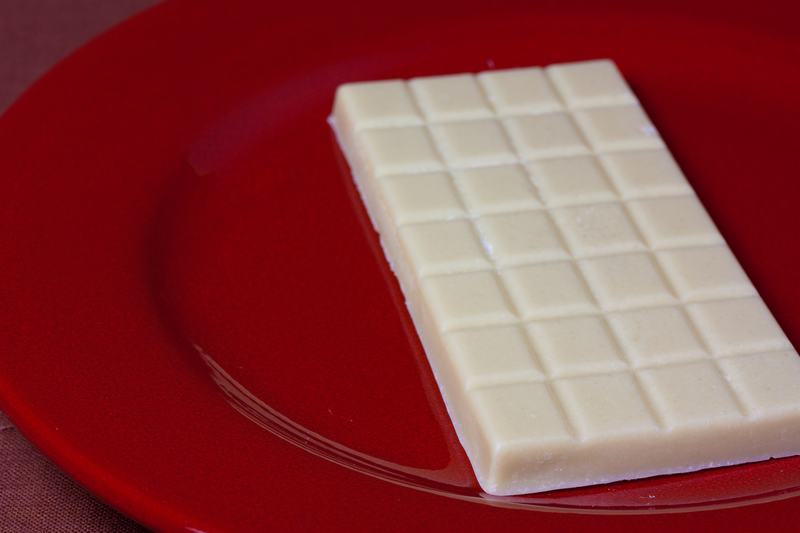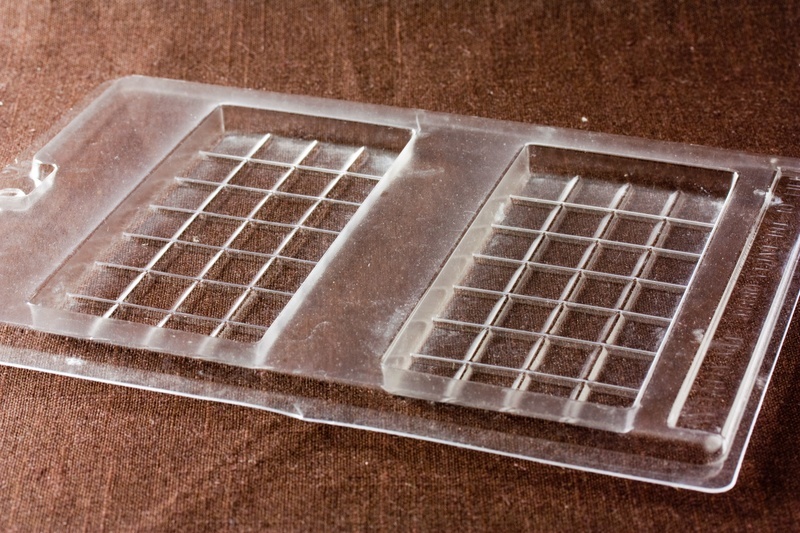Veganbaking.net
Vegan Baking Recipes
Vegan Confection Recipes
Vegan Candy Recipes
Vegan White Chocolate
Vegan White Chocolate
7

Commercial vegan white chocolate is relatively difficult to find but is an extremely versatile ingredient to have in your kitchen. Luckily, white chocolate's main ingredient, cocoa butter, is easy to find at affordable prices on the internet if you can't find it at your local health food store. A touch of soy milk powder and vanilla extract enhances depth of flavor in this chocolate.
Earlier attempts at making this Vegan White Chocolate recipe have resulted in excessively grainy bars due to the absence of industrial chocolate making equipment. A few extra steps will ensure this bar is as smooth as possible. Grinding your soy milk powder in a rotary coffee grinder will make the powder granules as small as possible and cause them to not be as noticeable on the palate. Tempering the chocolate to ensure proper fat crystal formation is the other crucial step to ensuring a smooth, high quality bar. Once you've mastered these steps you can add flavorings like cardamom, matcha, cinnamon and ginger powder for a truly outstanding vegan white chocolate.
Find more White Chocolate recipes on Veganbaking.net
Vegan White Chocolate Recipe
1 teaspoon soy milk powder¼ cup + 1 Tablespoon confectioners sugar
pinch of salt
2.1 ounces (1/3 cup) cocoa butter
½ teaspoon vanilla extract, alcohol-based
1) Grind the soy milk powder then sift it with the confectioners sugar
To ensure your chocolate is as smooth as possible, run the soy milk powder through a rotary coffee grinder. Sift the soy milk powder, confectioners sugar and salt into a medium mixing bowl and set aside.2) Whisk together the cocoa butter, soy milk powder, sugar and vanilla
Add the cocoa butter to a small saucepan and melt over medium heat. Alternatively, the cocoa butter can be melted in the microwave. Transfer the mixture to a double boiler and whisk until smooth. Whisk in the soy milk powder, confectioners sugar and salt mixture followed by the vanilla extract. Continue whisking until smooth.3) Temper the chocolate
This process is critical when making chocolate that has a smooth mouthfeel and has that snap when you break a piece of it off. If you're not going to temper than you shouldn't make chocolate because the grainy texture won't make it worth the effort. Tempering is really easy with a double boiler and a good thermometer. Once you grasp the theory it becomes even easier.Tempering is all about encouraging the fat to solidify, also known as crystallize, a specific way that results in dense, not too jagged crystals that pack together tightly. The result is chocolate that is dense, smooth and breaks with a snap. Tempered chocolate is also more resistant to bloom which is when fat crystallizes on the surface of the chocolate that resembles white dust.
There are 6 known fat crystal types in cocoa butter: Forms I, II, III, IV, V and VI. In tempering, the specific desired type of crystals, known as Form V crystals, melt at a temperature of 90F (32C) for dark chocolate and about 87F (31C) for white chocolate. We encourage, or seed these tiny crystals into our chocolate by first melting all other undesirable forms that melt at other temperatures. The crystal forms that melt at lower temperatures than Form V are Form I through Form IV and the crystal form that melts above Form V is Form VI. Bringing the mixture to a temperature of 120F (49C) melts all Forms. Think of this step as hitting the reset button on your chocolate so now you have a clean slate as far as the fat crystals are concerned. Now you need to bring the chocolate down to a low temperature so all of the fat Form types have been initiated. Bringing the temperature down to about 79F (26C) ensures this. We then increase the temperature until the Form V crystals have been melted which is 87F (31C) before pouring the chocolate. After the chocolate is poured into the mold it's important to let it sit at room temperature and not immediately be placed in the refrigerator. This ensures the Form V crystals have time to develop.
In summary: bring the mixture up to 120F (49C) while whisking frequently. Remove the bowl containing the mixture from the double boiler. Place the mixture in the refrigerator periodically and whisk occasionally to allow the mixture to reduce to 79F (26C). Now place the mixture back on the double boiler and bring it up to 87F (31C). If you overshoot and the temperature goes past 89F (32C), start the tempering process over.
Learn more about how to temper chocolate.
4) Pour the vegan white chocolate into a mold
Pour the mixture into your preferred chocolate mold. You can order chocolate bar molds online or get creative pour the chocolate ½ inch high in paper cups. Lift your mold up about an inch or so and drop it onto the counter top a couple times to release excess air bubbles. Allow the chocolate to solidify at room temperature overnight if possible to allow it to crystallize properly. If your kitchen is too hot for the fat to solidify then place it in the refrigerator after about 30 minutes. Remove the white chocolate from the mold and store it in an air tight container for up to 6 months in a cool, dark place. This recipe makes 3.5 ounces of Vegan White Chocolate.

